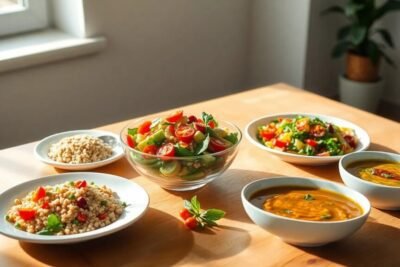
Diabetic-Friendly Foods to Eat: A Comprehensive Guide
- Understanding Diabetes and Nutrition
- The Importance of a Balanced Diet
- Low Glycemic Index Foods
- Fiber-Rich Foods: A Sweet Solution
- Incorporating Healthy Fats
- Proteins: Building Blocks for a Healthy Life
- Meal Planning for Diabetic-Friendly Eating
- Hydration and Diabetes
- Conclusion: Making Healthier Choices
Understanding Diabetes and Nutrition
Diabetes is a chronic health condition that occurs when the body is unable to adequately process glucose, resulting in elevated blood sugar levels. There are primarily two types of diabetes: Type 1 and Type 2. Type 1 diabetes is an autoimmune condition where the pancreas produces little to no insulin, a hormone crucial for glucose regulation. In contrast, Type 2 diabetes is more common and often associated with lifestyle factors, where the body either becomes resistant to insulin or fails to produce sufficient insulin to maintain normal glucose levels.
Nutrition plays an essential role in managing diabetes and is pivotal in controlling blood sugar levels. Individuals living with diabetes need to focus on foods that promote stable glucose levels and enhance insulin sensitivity. The choice of diabetic friendly foods to eat can significantly impact the disease management and overall health. Foods high in fiber, such as whole grains, legumes, and vegetables, are particularly beneficial as they help slow the absorption of sugar in the bloodstream.
Moreover, understanding the glycemic index (GI) of foods is crucial for diabetics. The GI is a ranking of carbohydrate-containing foods based on their effect on blood glucose levels. Low-GI foods, such as most fruits, non-starchy vegetables, and some whole grains, are preferred as they lead to a gradual rise in blood sugar, minimizing spikes that can be detrimental to diabetic health.
In addition to carbohydrate management, it's important for diabetics to include healthy fats, such as those from avocados and nuts, and lean proteins, which can help maintain blood sugar levels. Thus, adopting a balanced and thoughtful approach to nutrition can be one of the most effective strategies for individuals aiming to manage diabetes effectively, making the selection of appropriate diabetic friendly foods to eat imperative.
The Importance of a Balanced Diet
A balanced diet is critical for individuals living with diabetes, as it plays a fundamental role in managing blood sugar levels while ensuring the body receives essential nutrients. Such a diet emphasizes moderation and variety, including the appropriate proportions of carbohydrates, proteins, and fats tailored to diabetic needs.
In the context of diabetic friendly foods to eat, carbohydrates require particular attention. Carbohydrates significantly influence blood glucose levels, therefore, it is essential to select complex carbohydrates over simple sugars. Foods such as whole grains, legumes, fruits, and vegetables should be prioritized. These sources not only provide energy but also come with fiber, which helps in slowing the absorption of glucose. When meal planning, a general guideline suggests that carbohydrates should constitute about 45-60% of total daily caloric intake for diabetics.
Next, proteins also play a vital role in a balanced diet for diabetics. They are essential for tissue repair, muscle development, and overall bodily function. Lean protein sources such as chicken, fish, tofu, and legumes should be incorporated into meals, typically constituting around 15-20% of caloric intake. These proteins do not induce significant spikes in blood sugar levels, making them a favorable choice for diabetic friendly foods to eat.
Lastly, healthy fats should not be overlooked. These include unsaturated fats found in olive oil, avocados, and nuts. They can contribute to feelings of satiety and provide essential fatty acids. When included in moderation, fats should comprise about 20-35% of total daily calories. This balance not only promotes cardiovascular health but also aids in the overall management of diabetes.
By understanding the importance of macronutrients and their appropriate proportions, individuals with diabetes can make informed choices regarding diabet friendly foods to eat. This, in turn, fosters better blood sugar control and enhances overall health.
Low Glycemic Index Foods
The Glycemic Index (GI) is a significant tool for individuals with diabetes, as it rates foods based on their potential to raise blood sugar levels. Foods with a low GI score (55 or less) are absorbed slowly, leading to a gradual increase in blood sugar. Integrating low glycemic index foods into one’s diet is essential for effective blood sugar management and can enhance overall health for diabetics.
Common examples of low-GI foods include most non-starchy vegetables, whole grains, legumes, and certain fruits. Non-starchy vegetables like spinach, broccoli, and carrots provide fiber and essential nutrients without spiking blood glucose levels. Whole grains such as quinoa, barley, and whole-grain bread are excellent carbohydrate sources that release energy steadily. Similarly, legumes such as lentils and chickpeas not only offer low GI benefits but also provide protein and fiber, which are beneficial for satiety and digestive health. Among fruits, berries, cherries, and apples have a low GI and can be enjoyed in moderation.
Incorporating these diabetic-friendly foods into daily meals can be straightforward and fulfilling. For breakfast, consider oatmeal topped with berries or low-fat yogurt mixed with nuts and seeds. For lunch, a salad filled with leafy greens, tomatoes, and a protein source such as beans or grilled chicken can hold the GI in check. Dinner might include a serving of grilled salmon alongside quinoa and steamed broccoli. Snacking can involve low-GI options like a small handful of almonds or a piece of fruit. These strategies not only promote stable energy levels but also help maintain balanced blood sugar, making them indispensable for those managing diabetes.
Fiber-Rich Foods: A Sweet Solution
In the context of a diabetic-friendly diet, fiber-rich foods play a crucial role in managing blood sugar levels. Fiber is a type of carbohydrate that the body cannot digest, which means it has a minimal impact on blood sugar. When consumed regularly, fiber helps to slow down the absorption of sugar in the bloodstream. This regulation is key to maintaining stable blood glucose levels and preventing spikes that can be harmful to people with diabetes.
Moreover, dietary fiber promotes digestive health by aiding in regular bowel movements and preventing constipation, a common issue for those with diabetes. Fiber can be categorized into two types: soluble and insoluble. Soluble fiber, found in foods such as oats, beans, and certain fruits, forms a gel-like substance in the gut. This can help lower LDL cholesterol and improve heart health, an important consideration for diabetics. Insoluble fiber, which is present in whole grains, nuts, and vegetables, contributes to the bulk of stool and supports overall digestive function.
Incorporating fiber-rich foods into everyday meals does not need to be complicated. One practical approach is to replace white bread and pasta with whole grain varieties, which provide more fiber and nutrients. Including legumes like lentils and chickpeas in salads or soups can enhance fiber intake significantly. Snacking on raw vegetables or nuts is another excellent way to increase fiber consumption throughout the day while enjoying a healthy treat.
Fruits such as berries, apples, and pears can also be excellent additions to a diabetic-friendly diet due to their fiber content. Instead of reaching for processed snacks, consider preparing smoothies or oatmeal topped with fresh fruit to ensure a balanced meal. With these simple adjustments, one can enjoy a variety of fiber-rich foods that not only contribute to blood sugar regulation but also promote overall health for individuals managing diabetes.
Incorporating Healthy Fats
When considering diabetic-friendly foods to eat, the inclusion of healthy fats plays a pivotal role in a well-rounded diet. It is essential to understand the difference between good fats and bad fats, as they can significantly impact blood sugar levels, heart health, and overall well-being. Healthy fats, primarily monounsaturated and polyunsaturated fats, are known for their beneficial effects on insulin sensitivity and cholesterol levels, making them crucial for individuals managing diabetes.
Sources of healthy fats include avocados, nuts, seeds, and olive oil. Avocados, for instance, are rich in monounsaturated fats and fiber, which can help stabilize blood sugar levels while providing essential nutrients. Nuts, including almonds and walnuts, not only offer healthy fats but also contain important vitamins and minerals that support metabolic health. Additionally, seeds such as flaxseeds and chia seeds are excellent sources of omega-3 fatty acids, which are beneficial for heart health.
Olive oil stands out as a key ingredient in many diabetic-friendly foods, lauded for its high concentration of monounsaturated fats. Regular consumption of olive oil has been linked to improved insulin sensitivity and reduced inflammation, making it an ideal choice for those with diabetes. It is important, however, to consume these healthy fats in moderation, as they are calorie-dense, and excessive intake can lead to weight gain and other health issues.
Incorporating these healthy fats into daily meals can significantly enhance not only the flavor of dishes but also the nutritional profile, creating a balanced approach to managing diabetes. Whether drizzling olive oil over salads or snacking on a handful of nuts, these choices reflect a mindful integration of diabetic-friendly foods to eat that promote better health outcomes.
Proteins: Building Blocks for a Healthy Life
Protein plays an essential role in the management of diabetes, serving as a vital component for muscle maintenance, weight management, and overall health. For individuals managing diabetes, maintaining a balanced diet that emphasizes diabetic-friendly foods to eat is crucial. Proteins contribute to satiety, helping to curb hunger and reduce the likelihood of overeating, which can be particularly beneficial for those trying to achieve or maintain a healthy weight.
When considering protein sources suitable for a diabetic-friendly diet, several options stand out. Lean meats, such as skinless chicken, turkey, and lean cuts of beef, provide high-quality protein with relatively low saturated fat content. Fish, such as salmon and mackerel, not only provide protein but are also rich in omega-3 fatty acids, which can be helpful for heart health, an essential consideration for those living with diabetes.
Legumes also present an excellent option for individuals seeking diabetic-friendly foods to eat. Beans, lentils, and chickpeas are not only packed with protein but also offer complex carbohydrates, fiber, and essential nutrients. This combination can help in managing blood sugar levels, making legumes a wise choice for those with diabetes. Furthermore, dairy products like Greek yogurt and cottage cheese can serve as convenient protein sources; they offer additional benefits such as calcium and probiotics, which can support digestive health.
To effectively balance protein intake throughout the day, it is important for individuals with diabetes to distribute protein consumption across meals. Incorporating a protein source at each meal helps maintain steady energy levels and can support blood sugar control. By integrating a variety of protein sources into the diet, individuals can enjoy a range of flavors and textures while ensuring they consume healthy, diabetic-friendly foods that support their overall health and well-being.
Meal Planning for Diabetic-Friendly Eating
Meal planning is an essential strategy for individuals with diabetes, as it helps in maintaining stable blood sugar levels while ensuring that nutritional needs are met. When focusing on diabetic-friendly foods to eat, it is crucial to prepare balanced meals in advance. This not only saves time but also reduces the likelihood of making impulsive choices that may not align with a healthy diet. Begin by selecting a variety of foods rich in fiber, lean proteins, healthy fats, and low-glycemic carbohydrates. Consider incorporating whole grains, legumes, and a wide range of vegetables, as these provide vital nutrients and keep blood sugar levels in check.
When planning meals, portion control is paramount. Utilizing measuring cups or a food scale can assist in ensuring that serving sizes are appropriate. Additionally, organizing meals around the plate method can be beneficial: fill half the plate with non-starchy vegetables, one-quarter with lean protein, and the remaining quarter with whole grains or starchy vegetables. This framework helps in visualizing appropriate portions of diabetic-friendly foods.
Dining out can pose challenges for those adhering to a diabetic-friendly eating plan. It is advisable to review the menu beforehand and identify healthier options. Request modifications where necessary, such as substituting fried items with grilled or steamed options. Furthermore, being mindful of hidden sugars in sauces and dressings can greatly impact blood glucose levels. When selecting snacks, aim for those that are high in protein and fiber, such as nuts, yogurt, or fresh fruit, as they align well with the principles of a diabetic-friendly diet.
Implementing these practical tips for meal planning ensures a balanced approach to diabetic-friendly eating, making it easier to maintain a stable blood sugar level while enjoying a diverse array of foods.
Hydration and Diabetes
Proper hydration is a crucial aspect of managing diabetes, as it plays a significant role in maintaining overall health and optimal blood sugar levels. When individuals with diabetes are sufficiently hydrated, they may experience improved metabolic function, facilitating better glucose control. Moreover, staying hydrated can help reduce the risk of complications associated with diabetes, such as kidney disease and cardiovascular issues.
Water is undoubtedly the best beverage choice for individuals managing diabetes. It contains no sugars, calories, or carbohydrates, making it an ideal option for maintaining hydration without adversely affecting blood glucose levels. Consuming adequate amounts of water can also help flush out excess sugar from the bloodstream, further supporting blood sugar management. A general recommendation is to drink at least 8-10 glasses of water daily, though individual needs may vary based on factors such as activity level and climate.
In addition to water, herbal teas are another excellent option for hydration. Varieties such as chamomile, peppermint, and hibiscus provide numerous health benefits without adding sugar or calories. These teas can be enjoyed hot or iced and offer a refreshing alternative to sugary beverages. However, it is important to avoid teas with added sweeteners or those that contain high amounts of caffeine, as these can lead to dehydration and negatively impact blood sugar regulation.
On the contrary, sugary drinks, including sodas, fruit juices, and sweetened teas, should be limited or avoided altogether. These drinks can cause rapid spikes in blood sugar levels, making it challenging to maintain stable glucose control. Instead, focusing on diabetic-friendly foods to eat alongside proper hydration can further enhance overall health and well-being for individuals managing diabetes. Prioritizing water and herbal teas while consciously reducing sugary beverage intake is essential for effective diabetes management.
Conclusion: Making Healthier Choices
In summarizing the vital points discussed in this comprehensive guide on diabetic-friendly foods to eat, it is clear that making informed dietary choices plays a crucial role in effectively managing diabetes. A variety of nutrient-dense foods, including fruits, vegetables, whole grains, lean proteins, and healthy fats, not only support blood sugar control but also promote overall well-being. Understanding the glycemic index of foods allows individuals with diabetes to select options that minimize spikes in blood glucose levels, thus empowering them to take charge of their health.
Additionally, exploring alternatives to high-sugar and high-carbohydrate foods can lead to more satisfying meals that align with dietary restrictions. By incorporating foods that are low in sugar and high in fiber, individuals can feel full without compromising their health. The emphasis on whole, unprocessed foods also extends beyond diabetes; it contributes to long-term health benefits for everyone, irrespective of their dietary needs.
Furthermore, we encourage our readers to actively seek information and resources that support diabetes management. Engaging with professional nutritionists, diabetes educators, and credible online platforms can provide personalized guidance tailored to individual lifestyles. Sharing success stories and tips within communities can forge stronger support networks for those navigating the challenges of diabetes.
Ultimately, choosing diabetic-friendly foods to eat is not merely a dietary requirement but an empowering journey toward improved health. By fostering healthy eating habits and staying informed, individuals with diabetes can significantly enhance their quality of life. We invite you to explore more resources and engage with our portal for further information, support, and community interaction in your journey toward better management of diabetes.










